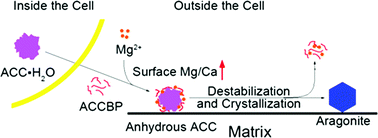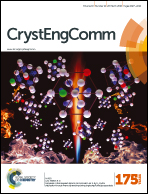Transformation of amorphous calcium carbonate nanoparticles into aragonite controlled by ACCBP†
Abstract
Polymorph selection during shell or pearl formation has been an intriguing issue, especially for those species of interest for human consumption. The polymorph switching of calcium carbonate controlled by amorphous calcium carbonate-binding protein (ACCBP), an extrapallial fluid (EPF) protein from the pearl oyster identified by our group in 2007, is investigated in this research. FTIR and TGA analysis suggest that ACCBP decreases the bound water content of amorphous calcium carbonate (ACC), suggesting that ACCBP may be involved in biogenic anhydrous ACC formation. In vitro crystallization and ACC transformation experiments show that ACCBP induces aragonite formation via an ACC precursor in Mg/Ca = 1 and Mg/Ca = 2 solutions at low temperature. Raman, FTIR, ICP and XPS analyses of the initial-stage ACC nanoparticles in the ACC transformation experiment suggest that this polymorph switching may be controlled by increasing the surface Mg/Ca ratio of the ACC, rather than by regulating the bulk Mg/Ca ratio or the short-range ordered structure. These results suggest that the polymorph selection in nacre or pearl growth may be controlled not only by the nucleating template on the matrix but also by the physicochemical effects of EPF proteins.


 Please wait while we load your content...
Please wait while we load your content...